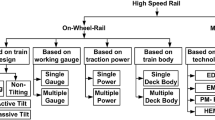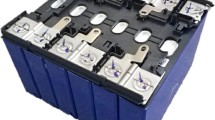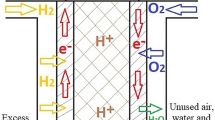Abstract
To improve the efficiency and life of in-wheel motor in micro-electric vehicle, thermal loss and temperature field are calculated and analyzed. The mathematical model of thermal loss and temperature field was established, the equivalent model of stator winding was adequately handled, convection heat transfer coefficients was calculated, and the heat distribution of in-wheel motor was analyzed. Winding copper loss, stator and rotor core loss and eddy current loss of permanent magnet were calculated, which were coupled to the temperature field as the heat sources. This paper effectively simplified and dealt with the inner complex radiating coefficient. Three-dimensional finite element model of temperature field was established, and static and transient state temperatures were simulated and analyzed. Overall temperature of the stator region is higher than that of the rotor region. Temperature of stator iron core is basically accord with the temperature of equivalent insulating film, but both are less than the temperature of equivalent winding. The conformity of the measurement results with the final simulation results shows that three-dimensional finite element method is accurate and feasible to analyze thermal loss and temperature distribution of in-wheel motor, which can afford a theoretical basis to optimize the in-wheel motor.
Similar content being viewed by others
References
K. H. Guo, The industrialization problems of electric vehicles in China, Engineering Science, 13 (9) (2011) 5–8.
H. Zhao, C. Psanis and T. Ma, Analysis of air hybrid engine concept with an energy recovery valve, International Journal of Vehicle Design, 55 (1) (2011) 49–75.
K. Christian, T. G. Habetler and R. G. Harley, Rotor temperature estimation of squirrel-cage induction motors by means of a combined scheme of parameter estimation and a thermal equivalent model, IEEE Transactions on Industry Applications, 40 (4) (2004) 1049–1056.
Y. K. Huang, Q. S. Hu and J. G. Zhu, Magneto-thermal analysis of a high-speed claw pole motor considering rotational core loss, Transactions of China Electrotechnical Society, 25 (5) (2010) 54–60.
S. Y. Li and M. Yang, Analysis of the temperature field distribution for piezoelectric plate-type ultrasonic motor, Sensors and Actuators A: Physical, 164 (1) (2010) 107–115.
Jamal M. I. Lamghari, J. Fouladgar and E. H. Zaim, A magnetothermal study of a high-speed synchronous reluctance machine, IEEE Transactions on Magnetics, 42 (3) (2006) 1271–1274.
Y. Tai and Z. M. Liu, Analysis on three-dimensional transient temperature field of induction motor, Proceedings of the CSEE, 30 (30) (2010) 114–120.
Y. Z. Ge and S. G. Wang, Analysis and calculation of stator temperature field of permanent magnet brushless DC motor for electric bicycle, Micromotors Servo Technique, 41 (12) (2008) 5–8.
H. L. Zhang, J. B. Zhou, X. Chen and S. L. Jiang, The calculation of stator iron losses and magnet pole eddy-current loss for PMSM and influence on temperature field distribution. Small & Special Electrical Machines, 35 (5) (2008) 1–5.
J. C. Cao, W. L. Li and S. K Cheng, Temperature field calculation and associated factor analysis of induction motor with compound cage rotor, Proceedings of the CSEE, 28 (30) (2008) 96–103.
W. L. Li, S. F. Li and Y. Xie, Stator-rotor coupled thermal field numerical calculation of induction motors and correlated factors sensitivity analysis, Proceedings of the CSEE, 27 (24) (2007) 85–91.
T. C. Jin, W. L. Li and S. F. Li, Numerical calculation and analysis of stator thermal field in an induction machine, Electric Machines and Control, 10 (5) (2006) 492–497.
S. L. Ho and W. N. Fu, Analysis of indirect temperature rise measurements of induction machines using time stepping FEM, IEEE Transactions Energy Conversion, 16 (1) (2001) 55–60.
Q. P. Chen, H. Y. Shu and L. M. Chen, Simulation analysis of cogging torque of permanent magnet synchronous motor for electric vehicle. Journal of Mechanical Science and Technology, 26 (12) (2012) 1–7.
H. Takashi and K. Norimichi, A new technique to measure the temperature of a rotating motor shaft, Applied Thermal Engineering, 29 (2) (2009) 317–323.
Author information
Authors and Affiliations
Corresponding author
Additional information
Recommended by Associate Editor Sung Hoon Ahn
Qiping Chen received his Ph.D. in Mechanical Engineering in 2013, from Chongqing University, Chongqing, China. He is currently a Lecturer of School of mechatronics engineering, East China Jiaotong University, China. His research interests include electric vehicles, hybrid vehicles, mechatronics, etc.
XuelanYang received her M.S. in artistic design in 2013, from Sichuan University, Chengdu, China. He is currently a Lecturer of School of civil engineering and architecture, East China Jiaotong University, China. Her research interests include electric vehicles, landscape design, automobile design, etc.
Rights and permissions
About this article
Cite this article
Chen, Q., Yang, X. Calculation analysis of thermal loss and temperature field of in-wheel motor in micro-electric vehicle. J Mech Sci Technol 28, 3189–3195 (2014). https://doi.org/10.1007/s12206-014-0728-8
Received:
Revised:
Accepted:
Published:
Issue Date:
DOI: https://doi.org/10.1007/s12206-014-0728-8




